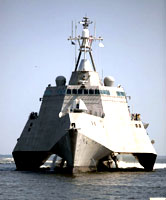
Independence Class LCCS
It is never a good sign for a new class of Navy ships when an article about them appears on the front page of the New York Times. The article, Navy Plowing Ahead on New Coastal Ship, Despite Woes by Elisabeth Bumiller, focuses on the construction of the Navy’s new Littoral Combat Ships (LCS), which Ms. Bumiller describes as “one of the most tortured shipbuilding programs in Navy history, a decade-long tale of soaring costs, canceled contracts and blown deadlines.” Given the history of Navy shipbuilding, that is saying quite a lot.
The Littoral Combat Ships are intended to be fast, agile and inexpensive, that is, inexpensive, at least by Navy standards. As their name suggests, they are intended to operate in littoral waters, along the coast. The current plan is to build 55 of these little ships in two classes. The Independence Class LCCS is a trimaran designed to operate at speeds up to 50 knots. The Freedom class LCS is an almost 400 foot long vessel with a conventional single hull capable of 47 knots.
The fleet of LCS are increasingly important to the Navy as they retire aging frigates and minesweepers, whose missions the LCS are supposed to take over. So far, not all has gone smoothly. Costs have risen as the Navy chose to build two different designs. Senator John McCain, an Arizona Republican and onetime Navy pilot, said in late 2010, “The story of this ship is one that makes me ashamed and embarrassed as a former Navy person.” The first two ships, one of each design, cost approximately $700 million each. The Navy is now promising that future vessels will be delivered for less than $400 million each.
The ships have had their share of technical issues as well. The first LCS, the USS Freedom has had significant cracking problems. The second LCS, the trimaran USS Independence, has had significant corrosion problems related to dissimilar metals in the hull and propulsion systems. The high speed mine sweeping capabilities of the Independence class have also failed in sea trials. To make matters worse, a report late last year by the Pentagon’s top weapons tester said the ship “is not expected to be survivable in a hostile combat environment.”
Nevertheless the construction programs continue at full speed. “It’s one of those things that once the snowball goes down the hill, it just keeps rolling,” said Representative Duncan Hunter, a California Republican who has been one of the ship’s biggest critics but said he was bowing to the inevitable. “The Navy likes it. There’s no way I’m going to stop it.”
Cracked, Leaking And Limping Along
Within the Navy, the LCS have acquired a variety of nicknames, “Little Crappy Ship” being perhaps the most popular. The New Wars blog has cataloged a list of several dozen less than complementary possible nicknames based on the LCS acronym.

Why is the Navy continuing to throw good money after bad ? This is a prime example of waste in the Defense budget. Cut the program and cut the losses. What good is a warship if it cannot survive in a hostile combat environment. It seems to me the Navy brass is kowtowing to Congressional pressure to keep jobs in certain districts, regardless of the waste of money now, and the future waste of sailors lives in future combat.
Pingback: Bootjesgek.nl » Munitie voor een defensiedebat
Pingback: Peperdure marineschepen VS ‘onder vuur’ | Bootjesgek.nl